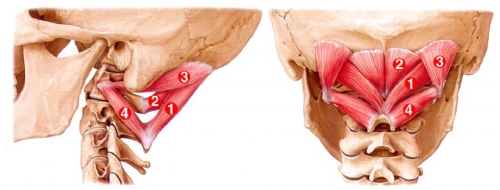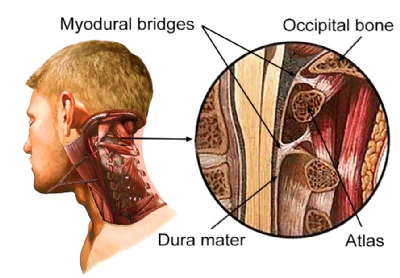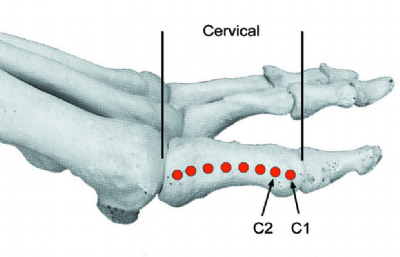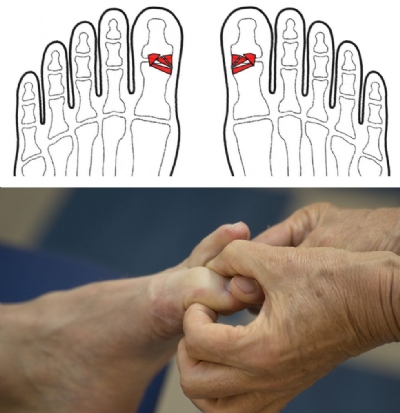Do you have eyes at the back of your neck?
By Dorthe Krogsgaard and Peter Lund Frandsen, Touchpoint Denmark
The small deep neck muscles are highly important for head movements and neck comfort, but overlooked by many therapists and rarely taught in basic reflexology training. We are talking about the so-called suboccipital muscles, which connect the cranium to the two upper neck vertebrae and perform many important functions that affect far more than the neck.
Anatomy
We have eight suboccipital muscles, four on each side. Like small springs, they extend between the basis of the cranium and the spinous and transverse processes of the atlas and axis. See Latin names and exact locations on Figure 1.
The muscles receive their nervous supply from the dorsal branches of the upper two spinal nerves (C1 and C2). These branches are particularly thick, due to the many muscle spindles found in these muscles (see below).

Figure 1 The suboccipital muscles: 1) Rectus capitis posterior major
2) Rectus capitis posterior minor, 3) Obliquus capitis superior, 4) Obliguus capitis inferior.
Function
If we consider the neck as one large joint connecting the head with the back, the small neck muscles are those who fine-tune the head movements. More superficially, we find larger and larger muscles adding force to the movements.
In various combinations with each other, the suboccipitals may side bend, rotate and extend the neck/head.
Small sensory organs
Although the muscles play a role for small movements of the head, perhaps the most important is their function to serve as a sensory system, which records the heavy head's position relative to the force of gravity.
The suboccipital muscles contain an unusually large number of proprioceptors or muscle spindles. 36 spindles per gram of muscle tissue whereas, for example the gluteus maximus has less than 1 spindle per gram of tissue. The proprioceptors measure tension in the muscles, telling the brain about the position of the head and neck. This information is crucial in order to coordinate all muscles of the body and keep the balance when we move.
Eyes in the neck – try for yourself
You can easily feel the connection if you place your hands on either side of the head with your thumbs just below the edge of the skull. Slowly let your thumbs work through the outer muscle layers so that you have contact with deep muscles. Close your eyes. Now try to move the eyes from side to side, and up and down without moving the head. Can you feel the small tonus changes in the muscles? Although the head and neck are kept still, the suboccipital muscles respond to eye movements. From a developmental point of view we here have a very old connection that helps us to keep the balance and coordinate the entire musculoskeletal system.
Bridge to the dura mater
Within the past 15 years, anatomists have discovered the existence of small muscle/fascia strands connecting some of the suboccipital muscles with the dura mater, the outermost strong membrane surrounding the brain and spinal cord. They are called myo-dural bridges. The muscles, it seems, are thus able to pull on the dura sheath and prevent it from being pinched between the bones when the neck and head moves. Pathological tension in these muscles is therefore likely to increase tension in the dura and therefore affect the brain and cause headache or migraine. There are examples of surgical cutting of these myo-dural bridges having relieved chronic headaches.

Figure 2 Myo-dural bridges connecting the suboccipital muscles with the dura mater.
Muscle tension
With the all too common slumped posture with protruding shoulders and increased curvature in both the lower back, chest and neck the small neck muscles often have to work overtime to lift the head, so you can see straight ahead. The accompanying muscle tension may result in symptoms such as:
- Stiffness and/or pain in the neck
- Tension headache that pulls up from the neck and above the temples toward the back of the eyes
- Migraine
- Diffuse, deep pain, often described as if coming from inside the head
Treatment
Relaxation of the suboccipital muscle group is part of the treatment of these problems, but will have beneficial effects to the entire body. Eg. one can easily observe increased flexibility in the hamstrings immediately following release of the deep neck muscles. This is probably because these muscles play a superior role in orchestrating the movement system and because of the fact that they are directly linked to the dura mater and thus influence all of the spinal nerves.
Nerve Reflexology
In Touchpoint Clinic, for a specific treatment of the suboccipital muscles we will first work with the nervous supply, which in this case means nerve reflex points for C1 and C2, see Fig. 2. When we want to affect the dorsal branch of these nerves, we use a pressure direction directly against the bone from medial towards lateral. If the point is painful, we hold a stationary pressure until the pain has subsided or a maximum of 15 seconds.

Figure 3 Nerve reflex points for spinal nerves C1 and C2
Reflexology
Reflex zones for the suboccipital muscles are shown in Figure 4. We recommend working the areas thoroughly. A good technique is to gently bend the distal joint of the big toe, support with the thumb and index finger of one hand and work the reflexes using the side the other index finger.

Figure 4 zones and technology for the suboccipital muscles
Technique to release the suboccipital muscles
Deep relaxation of the muscle group and the whole neck area can be achieved using a technique inspired by the therapeutic modality of Ortho-bionomy:
- The client is lying supine with her head near the edge of the table.
- Stand with your feet apart and solid grounding.
- Gently hold the client's head with both hands over each other, making sure not to squeeze the ears.
- Slowly lift the head up.
- Ask the client to relax and let you carry the entire weight of the head.
- Move the head very slowly and gently around in different directions.
- Talk with the client so you are sure the technique feels secure and completely painless at all times.
- The aim is to get into a state where it feels as if the head determines where it would like to move, a gentle dance between you and the client's head/neck.
- Continue as long as it feels useful, preferably 2-3 minutes or more.
- If your arms get tired, then take a short break where you lower your hands (still holding the head) against the table.
- When you end the technique, do it very slowly so no muscles have to tighten up.
Releasing the neck
Figure 5 Ortho-bionomic release of the neck. Click the picture to view the video clip
This gentle movement of the head in the free directions often reprograms the nervous system to let old tension patterns go. The tricks are to make sure the client feels absolutely comfortable with what is going on, keeping full focus and respect the limitations of the muscles and joints.
Do you want to know more?
We work with the suboccipital muscles on the workshops “Round about: The Neck” and “Hands on: Headache”
References
Kahkeshani K1, Ward PJ.: Connection between the spinal dura mater and suboccipital musculature: evidence for the myodural bridge and a route for its dissection--a review. Clin Anat. 2012 May;25(4):415-22
Travel JG, Simons DG: Myofascial Pain and Dysfunction - The Triggerpoint Manual, Williams & Wilkins, 1983
Myers TW: Anatomy Trains, Churchill Livingstone, 2011
Krogsgaard D., Frandsen PL: Round about: The Neck, Touchpoint 2014
Krogsgaard D., Frandsen PL: Round about: Headache and Migraine, Touchpoint 2015
Ryesgade 27
DK-2200 Copenhagen N
Denmark
Tel: (+45) 2575 7047
Email >






